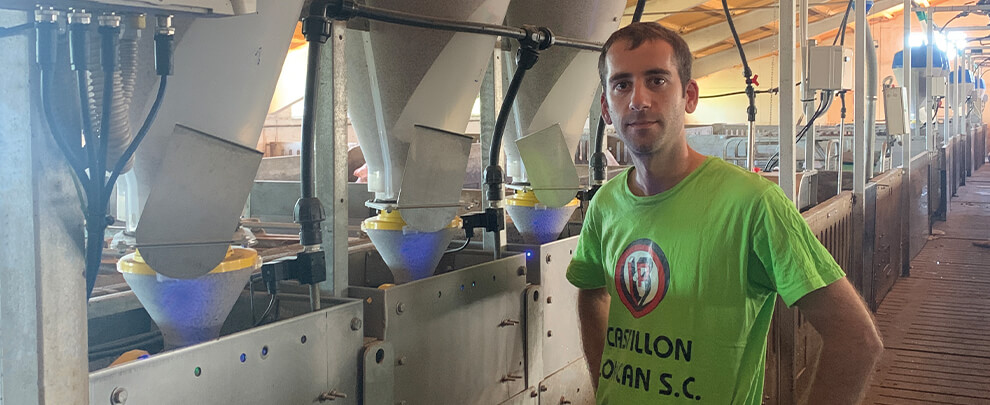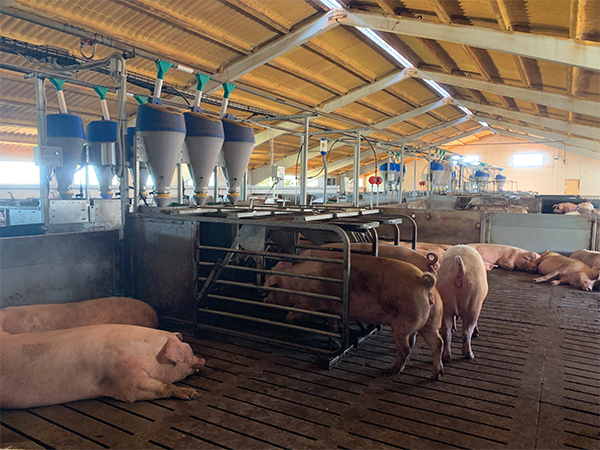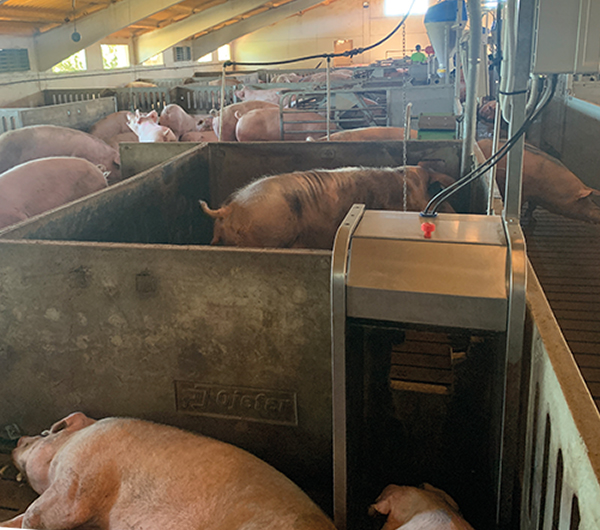Blog
Blog

D.C.: “With Dositronic G, we’ve increased the piglets born alive”
04 of October of 23 - Success stories
After the wholesome results obtained with Rotecna’s Dositronic M electronic feeding system for sows in farrowing, the Castillón brothers opted to install the version of this system for gestation, the Dositronic G, and thus have all the feeding data of their sows centralised in a single program. To learn about their work with Dositronic G, their advantages and the productive improvements they have achieved on their family farm, located in Alcolea de Cinca, we spoke with Daniel Castillón, responsible for the farm and his brother Miguel.
What are the beginnings of the farm?
It was my father, Jorge Castillón, who built the farm. He was a bricklayer and made his first fattening farm with his own hands. Later, with my mother, Mari Carmen Loncan, they decided to try their luck with sow farms and leave masonry. Although initially, we were working with sows and fattening, we finally decided to leave fattening and bet exclusively on sows.
How is the farm distributed?
The farm consists of three areas. The first was built between 1997 and 1998 and originally had 200 sows. In 2007, we expanded with a new warehouse to increase our capacity to 650 sows. Years later, we extended the quarantine of the first warehouse, built the weaning area and transformed the old weaning warehouses into farrowing wards. With this, we managed to reach the capacity of 1,200 sows, in addition to the spots for 5,000 piglets.
Who works on the farm?
My brother and I have three employees: two are in charge of farrowing wards, and another is in charge of cleaning tasks and animal arrangements. My brother is more dedicated to the management and organisation of the farm, and I am more dedicated to the issues of vaccination, sow movements, insemination and others.
In confirmed gestation, they have the Dositronic G. Why did you decide on this system?
We decided to use the Dositronic G in confirmed gestation because it is a system that sows easily get used to, and there is no risk of other sows biting the one eating, which is very important when you have issues with vulvar biting. In addition, the Dositronic allows perfect, individual and efficient feeding for all the sows at their most delicate moment, when the piglets are in gestation.

General view of the confirmed gestation shed with Dositronic G installed. Photo: Rotecna.
How do you work with the Dositronic G?
When we arrive in the morning, we first check the program’s data on the computer to know which animals have eaten less than 25% of what they should. This is the most important thing for us since most of the sows in that state are usually because their chip has failed or they have lost it. In addition, we also look at the program to see if there have been any incidents. On the other hand, after 28 days covered, when we take them to gestation, we write down the data of each sow (if they are fat, thin, if they need more food or less food) as it is essential when defining and managing the feeding curve in the program. At the same time that a new sow enters gestation, she can already enter to eat, and the computer will give her the amount of food according to the curve assigned to her so that her feeding is as efficient as possible.
What are the main advantages offered by the Dositronic G in gestation?
The most significant advantage of Dositronic G is that it allows efficient feeding of animals and water. The proportion of water and feed is controlled at all times. On the other hand, there is a significant saving in personnel since the sows eat alone, and you only have to ensure that everything goes well. In other words, it means less labour since the feed curve is programmed. Besides, it is a straightforward and intuitive system, so it does not require much time and effort on the worker’s part, and the animals adapt quickly. This also helps us to define the different groups of animals and their hierarchies while preventing any sow from eating the ration of another. Finally, the system allows individualised control of each sow, the amount of feed it consumes and the management of its feeding curve.
Productively, are there improvements?
At the production level, we have detected several improvements. The first and most important is that piglets born alive by calving have increased between one point and one and a half points. Secondly, the sow arrives at calving healthier and with more milk; Therefore, it can perform better gestation and lactation of piglets in the three weeks they are in farrowing.
In gestation, they also have the Rotecna in-heat detector. Why did you decide to use this product?
We went for the heat detector because it identifies the sows immediately when they are ready and in heat. When the sow is a few seconds beside the male’s pen, the sensor can determine with complete security if he is in heat. Furthermore, the detector has a spray marker that points to the sow and leaves it differentiated from the rest, so you do not waste time identifying or looking for the sows in heat.

The farm works with the heat detector. Photo: Rotecna.
On the other hand, in farrowing, you have installed the Dositronic M. Is it an advantage to work with the two electronic feeding systems from Rotecna?
One of the reasons we decided to install Dositronic G was because of the good results we obtained with Dositronic M. From the same operating system and with the same parameters, we can manage the gestation and farrowing feeding systems. In addition, to go from one to another, you have to click on a link in the program.
What other Rotecna products do you have?
Many of the products we have installed on our farm are from Rotecna. In addition to the Dositronics M and G, we have slats, separators, valves, dosers, heating plates, etc.
In general, what do you value about Rotecna?
What we value most about a company like Rotecna is its technical service, which is very efficient and helpful and, even remotely, can solve 99% of possible problems.
At the health level, what are your main concerns?
When it comes to diseases, we must be alert and very rigorous. PRRSV is very serious and difficult to control. However, having a clean, efficient, well-organised and managed farm is much easier to handle. On the other hand, the entry of replacement sows into the farm is one of the most contentious issues. The most significant entry route for infections has always been through quarantine, so we are committed to expanding and improving this area in infrastructure and equipment.
What biosecurity measures do you have in place?
In addition to the primary measures such as the shower at the farm entrance, the use of exclusive clothing for the facilities or the prohibition of introducing external material, we have different-coloured boots in each farm area. It is crucial not to take possible infections that we drag around with organic matter from one place to another, so we avoid this with boots. In addition, at the farm’s safety level in general, we have several systems, both for voltage drop and excess heat. In this sense, we have an alarm connected to the electric current in each of the rooms, windows that open when there is a power outage, etc.
What are the challenges for the future?
We plan to expand the group gestation area to ensure that the sows have more space and that their welfare is even better. On the other hand, we continue to increase and implement all the systems and work routines we are learning, which are very important for the farm’s production to grow.






